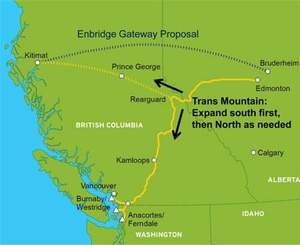Pipeline expansion to add 700 tanker transits in already-saturated southern BC waters
Animal Communication, News, Ocean, Shipping Add commentsBioacousticians and marine advocates have been closely following plans for the Northern Gateway pipeline in British Columbia, which would greatly increase ship traffic in some coastal waterways that are relatively quiet so far; see previous AEInews coverage. But another pipeline project, farther along in the permitting process, could push the already stressed waters of southern BC and northern Washington to the acoustic breaking point. The Trans Mountain Pipeline, built in 1953 and expanded several times since then, is gearing up to nearly triple its capacity and make adaptations that will allow heavy tar sands oil to be moved to the Pacific coast for shipment to Asia.
 The expanded Trans Mountain Pipeline would have 75% of the capacity of the proposed Keystone KL pipeline to the Gulf of Mexico, so it has triggered active resistance on similar climate change grounds as Keystone. At the same time, ocean advocates are stressing the cumulative impact of the additional 720 tanker transits that would occur in already-busy waters that include critical habitats for killer whales, sea lions, and other species. At this point, most of the additional capacity is targeted for Burnaby, BC (increasing monthly tanker arrivals from 5 to 34), though the pipeline also serves terminals in northern Washington state. (Some of the current capacity is refined and used in North America, but virtually all of the increased capacity will be shipped overseas; thus the tanker traffic will increase 7-fold despite the smaller capacity increase.)
The expanded Trans Mountain Pipeline would have 75% of the capacity of the proposed Keystone KL pipeline to the Gulf of Mexico, so it has triggered active resistance on similar climate change grounds as Keystone. At the same time, ocean advocates are stressing the cumulative impact of the additional 720 tanker transits that would occur in already-busy waters that include critical habitats for killer whales, sea lions, and other species. At this point, most of the additional capacity is targeted for Burnaby, BC (increasing monthly tanker arrivals from 5 to 34), though the pipeline also serves terminals in northern Washington state. (Some of the current capacity is refined and used in North America, but virtually all of the increased capacity will be shipped overseas; thus the tanker traffic will increase 7-fold despite the smaller capacity increase.)
The Canadian Department of Fisheries and Oceans has just released a review of the Trans Mountain proposal, which is currently being considered by the National Energy Board (NEB), and finds it lacking, saying it contains “insufficient information” to adequately assess the threats posed both by underwater noise and ship strikes. “The assessment considers noise from a single project-related ship, without taking into account the additive and cumulative effects of existing noise,” Fisheries and Oceans Canada concludes.
Marine advocates second that concern. Margot Venton, a staff lawyer with Ecojustice, stresses that “The critical habitat is basically as noisy as it can be. We need to make it quieter.” Misty MacDuffee, a fisheries ecologist with Raincoast Conservation Foundation, said anything that impedes the ability of whales to feed is a serious concern. “It’s just the growing din,” she said. “They are trying to [communicate and hunt] in an increasingly loud environment.” (Thanks to the Globe and Mail for their coverage and all these quotes.)
The NEB review is slated to be concluded by July; the federal government will then take six months to consider the NEB’s recommendation and make a final decision. If approved, construction could begin in 2016 and be completed the following year.
UPDATE, 7/14/16: The NEB has recommended that the pipeline be approved, despite the likelihood that additional ship traffic will saturate the acoustic environment to the point that ship noise is present in some areas nearly 100% of the time (currently 85%). Transmountain will need to meet 157 conditions, but they’re confident that will be achievable. The final stage of the approval process is a final decision from the Canadian government, which is expected by the end of this year.
